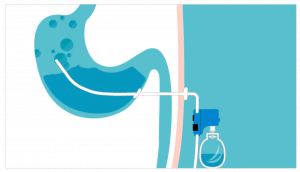Aspiration Therapy for obesity; a Safe and Effective Treatment or the 21st Century Tape Worm.
In obesity, you have to understand the root of what causes most obesity. Most obesity is not caused by a magical endocrine disorder or metabolic shortcoming that hinders someone from losing weight. The problem in obesity is overeating or under-exercising. Obesity in a large portion of the United States is an eating disorder called binge eating. Not all patients that binge eat meet the criteria for binge eating disorder. Exercise is a very small portion of the problem in reality but it is important to maintain good health.
Now that we know the problem let’s look at AspireAssist. The AspireAssist[1] appears to be the most intuitive weight-loss therapy recently proposed. In June of 2016, the FDA approved this treatment for obese patients with a BMI of 35-55 and over 22 years of age. It is not much different from a feeding tube in reverse. The procedure is a simple office procedure in which a gastric tube is inserted through the abdominal wall to the stomach (gastric). A scope is passed into the stomach from the mouth. With the aid of this endoscope, a physician cuts a small hole through to the surface, places an internal catheter into the hole, and pulls it out through the skin. This tube is connected to a pump after each meal and approximately 1/3 of the stomach contents are pumped out and into the toilet.
Does it work? Yes. One study looked at a population of 25 obese patients treated with the device. The starting mean
BMI was 40 and the mean BMI at one and two years was 32 and 31. At one year, the subjects lost 54% of their excess body weight. That was a significant decrease. There were no major metabolic or life-threatening complications, but compliance was an issue. Only 80% and 60% percent made it to years one and two respectively[2].
Risks of AspireAssist:
The risks are similar to having a standard gastric tube placed. Risks associated with endoscopic surgical placement of the gastric tube include pain, abdominal bloating, indigestion, bleeding, infection, nausea, vomiting, sedation-related breathing problems, inflammation of the abdominal lining, ulcers inside the stomach, unintended puncture of the stomach or intestinal wall, and death. These include abdominal discomfort or pain, irritation, hardening or inflammation of the skin around the site of the tube placement, leakage, bleeding and infection around the location where the tube is placed, and migration of the device into the stomach wall. A persistent opening between the stomach and skin may occur after the instrument is removed.
Major Contraindications of AspireAssist:
Contraindications for this device include uncontrolled hypertension, diagnosed bulimia or binge eating disorder, night eating syndrome, certain types of previous abdominal surgery, pregnancy or lactation, inflammatory bowel disease, or stomach ulcers. The device is also contraindicated in those with a history of severe pulmonary or cardiovascular disease, coagulation disorders, chronic abdominal pain, or patients with a high risk for medical complications from an endoscopic procedure.
Problems with this procedure:
- Binge eating is an eating disorder, and I think that all obesity is an eating disorder. To control an eating disorder, it is recommended that the key is proper behavioral health therapy to assist them in gaining insight into the cause of their disorder.
- Obese patients must learn a lifestyle change. Patients do receive one-on-one, and group lifestyle counseling is focusing on food choices, portion sizes, and increased physical activity. This direction is where I see the procedure going wrong. The major lifestyle change the patient learns is to chew their food thoroughly so it can be aspirated. Once the G-tube is removed, most will go back to eating as they did before.
- AspireAssist is very similar to Bulimia. Bulimics often take laxatives to absorb less food than they eat. This procedure is very similar but it is physician-assisted. I just don’t see the ethics in this one. I guess at least the research indicates this might be safer, but I suspect we need more research to call this treatment safe.
- Medication absorption is reduced or lost in pumping. If you must take oral medications, you would now require 1/3 higher dose if it is completely dissolved in the stomach. Medications are usually not this simple, but you get the point.
- Cost. The AspireAssist procedure can cost between $8,000 and $13,000. The cost includes the device, insertion, behavioral coaching, and follow-up doctor visits. Compared to the lifetime cost of obesity, that is a drop in the bucket or toilet. No pun intended.
If you needed to use this device for a life-saving purpose, then I would be more than supportive of its use. However, using this device for weight loss, in my opinion, is controversial, and despite the research, I suspect it is dangerous. It is important that we support our binge eating disorder patients with behavioral health therapy, and provide them with a means to change the behavior, and I do not see that with the “pump and dump” of AspireAssist. I feel the FDA showed a lack of judgment and foresight when they approved this device for the treatment of obesity without further testing to find the long-term implication of its use.
Recommendation on AspireAssist: The AspireAssist device takes a bold and novel approach to weight loss, and it could be a viable option for obese patients that are at wit’s end and have tried everything else. I would still say wait until there is more definitive research. I am just not sold on the safety and long-term efficacy yet. They only had 19 finish the first year of the study. It will be at least ten years till we know if it is safe and works for long-term weight loss. The bottom line is I would never consider this as an option even if I were morbidly obese and only time will tell if this is a legitimate treatment or if it will go the way of the tapeworm.










Be the first to comment on "Research: Aspiration Therapy Such as AspireAssist May be Safe and Effective"